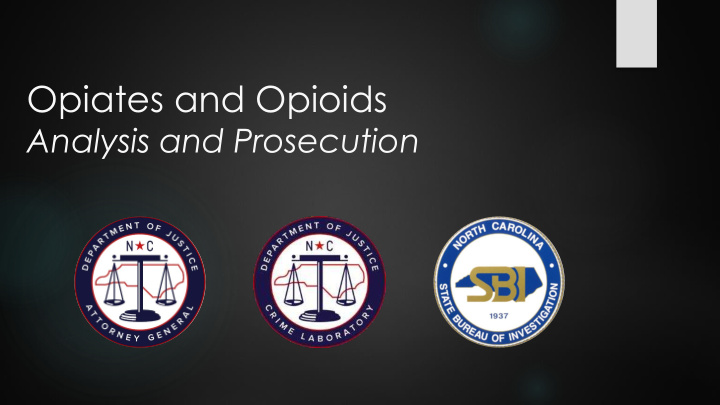



Opiates and Opioids Analysis and Prosecution
Katy Schell Forensic Scientist Manager Drug Chemistry Section North Carolina State Crime Laboratory Kschell@ncdoj.gov
North Carolina State Crime Laboratory Accredited under ISO/IEC 17025 standards by ANSI-ASQ National Accreditation Board (ANAB) Laboratory practices and methods: Nationally and Internationally accepted Validated prior to implementation Standards and controls present to ensure repeatability and reliability of test methods Locations: Raleigh, Greensboro, Edneyville/Hendersonville
North Carolina State Crime Laboratory Drug Chemistry Section Purpose: Analysis for presence or absence of controlled substances Preliminary Testing Confirmatory Testing Weigh using calibrated balances with applicable measurement assurance
North Carolina State Crime Laboratory Drug Chemistry Section Total drug cases submitted between January 1- June 30, 2018: 10,692 Average submitted per month: 1,782 cases Total cases worked 7693 (partially due to complexity of case samples) Average worked per month: 1,282 cases 35% of the total cases worked were opiate/opioid related
Preliminary and Confirmatory Testing Fourier Transform Infrared Spectrophotometer with Universal Attenuated Total Reflectance (FTIR-ATR) Gas Chromatograph Mass Sampling Accessory Spectrometer (GCMS) Color Tests
North Carolina State Crime Laboratory Drug Chemistry Section Multi-unit Population Analysis Administrative Sample Selection Threshold Sample Selection Hypergeometric Sampling
North Carolina State Crime Laboratory Drug Chemistry Section Administrative Sample Selection All pharmaceutical preparations No statutory weight threshold Threshold Sample Selection Statutory weight threshold applies Individual analysis is practicable
North Carolina State Crime Laboratory Drug Chemistry Section Hypergeometric Sampling Statistical analysis of a representative portion of the population Demonstrates with 95% confidence that at least 90% of the material contains the identified substance Statutory threshold Must have10 or more units in population Analysis of individual units not practicable
Heroin Trafficking Approximately 250g Heroin Heroin bindle (same weight as about 2 cups of flour) Average amount per bindle, 0.02g versus 4g trafficking amount Based on average weight of 0.02g – 200 bindles (4g), 700 bindles (14g), 1400 bindles (28g) thresholds
Heroin Trafficking Case Sample -3907 bindles total containing Heroin -Total weight 42g (~0.01g per bindle) -12 days of analysis time (case open to close)
Pharmaceutical Trafficking 28 grams 4 grams *Number of tablets to reach trafficking thresholds will depend on tablet(s) 14 grams present
Counterfeit Pharmaceuticals: Can you tell the difference? Pill presses becoming Pharmaceutical Percocet more common in (hydrocodone/acetaminophen) clandestine laboratory -Furanyl fentanyl operations -Fluoro isobutyryl fentanyl (FIBF) Quality of counterfeit pharmaceuticals is improving Pharmaceutical Oxycodone How do you know? -Oxycodone Confirmatory testing by -Methamphetamine an accredited forensic -Heroin laboratory -MMB-FUBINACA -Alprazolam -Furanyl fentanyl -Tramadol -U47700
North Carolina State Crime Laboratory Drug Chemistry Section Current N.C.G.S. Chapter 90 language “Any material, compound, mixture, or preparation which contains any quantity of the following…” “Any salt, compound, derivative, or preparation thereof…” Challenges to consider: What charges would apply for multiple controlled substances per unit? How handle counterfeit pharmaceutical tablets which contain the purported substance? Increasing weight thresholds = More drugs for dealers to sell before heavy penalties apply
North Carolina State Crime Laboratory Drug Chemistry Section Cost: What would it take to quantitate percentage of controlled substances in mixtures? New instrumentation/maintenance(~ $914,000) Rigorous revalidation of methods/training (~ 5 months) Change in Scope of Accreditation and reassessment (~ 1 month and ~ $15,000) Increase in number of pending cases and case turn-around time (TAT) Additional ~7700 cases added to pending backlog based on data from first 6 months of 2018
John Keane Special Agent in Charge North Carolina State Bureau of Investigation Diversion and Environmental Crimes Unit jkeane@ncsbi.gov
Overview of SBI Drug Diversion Operations Prescription Fraud Conspiracies Undercover Investigations Healthcare Diversion Doctor Shopping
Leslie Cooley Dismukes Criminal Bureau Chief North Carolina Department of Justice ldismukes@ncdoj.gov
State v. McCracken and DEA Lab Practices Heroin and Fentanyl Investigations and Prosecutions Sourcing Street value Organic vs. synthetic The difference between users and dealers The need for mandatory minimums for dealers Prosecutorial discretion
Recommend
More recommend